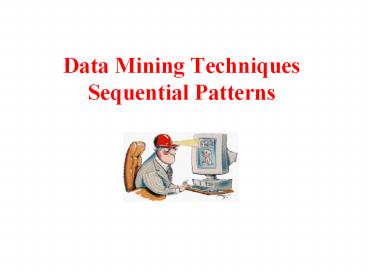Data Mining Techniques Sequential Patterns - PowerPoint PPT Presentation
Title:
Data Mining Techniques Sequential Patterns
Description:
Catalog companies also collect such data using the orders they receive ... 'Computer Science and Programming Language', followed by 'Data Structure' ... – PowerPoint PPT presentation
Number of Views:23
Avg rating:3.0/5.0
Title: Data Mining Techniques Sequential Patterns
1
Data Mining Techniques Sequential Patterns
2
Sequential Pattern Mining
- Progress in bar-code technology has made it
possible for retail organizations to collect and
store massive amounts of sales data, referred to
as the basket data - A record in such data typically consists of the
transaction date and the items bought in the
transaction - Very often, data records also contain
customer-id, particularly when the purchase has
been made using a credit card or a frequent-buyer
card - Catalog companies also collect such data using
the orders they receive
3
Sequential Pattern Mining
- An example of such a pattern is that customers
typically rent Star Wars (????), then Empire
Strikes Back (?????), and then Return of the
Jedi (?????) - These rentals need not be consecutive
- Customers who rent some other videos in between
also support this sequential pattern - Elements of a sequential pattern need not be
simple items - Computer Science and Programming Language,
followed by Data Structure, followed by System
Programs and Operating Systems is an example of
a sequential pattern in which the elements are
sets of items
4
Sequential Pattern Mining
- Given Transaction Time, Customer Id, Items Bought
Original Database
Answer Set
5
Definition
- The length of a sequence is the number of
itemsets in the sequence - A sequence of length k is called a k-sequence
- The support for an itemset i is defined as the
fraction of customers who bought the items in i
in a single transaction - The itemset i and the 1-sequence ltigt have the
same support - An itemset with minimum support is called a large
(frequent) itemset or litemset
6
AprioriAll Algorithm
- Each itemset in a large sequence must have
minimum support - Any large sequence must be a list of litemsets
- Finding all sequential patterns in five phases
- Sort Phase
- Litemset Phase
- Transformation Phase
- Sequence Phase
- Maximal Phase
7
AprioriAll AlgorithmSort Phase
Customer-Sequence Version of the Database
8
AprioriAll AlgorithmLitemset Phase
Apriori/DHP FP Growth
min_sup_count2
9
AprioriAll AlgorithmTransformation Phase
10
AprioriAll AlgorithmSequence Phase
Large 2-Sequences
Customer Sequences
Large 1-Sequences
2
Large 4-Sequences
Maximal Large Sequences
Large 3-Sequences
11
Sequence PhaseCandidate Generation
12
AprioriAll AlgorithmMaximal Phase
- The sequence lt(3) (4 5) (8)gt is contained in lt(7)
(3 8) (9) (4 5 6) (8)gt, since (3) ? (3 8), (4 5)
? (4 5 6) and (8) ? (8) - The sequence lt(3) (5)gt is not contained in lt(3
5)gt (and vice versa) - The former represents items 3 and 5 being bought
one after the other - The latter represents items 3 and 5 being bought
together. - In a set of sequences, a sequence s is maximal if
s is not contained in any other sequence.
13
AprioriAll Algorithm
Answer Set
- With minimum support set to 25, i.e., a minimum
support of 2 customers - lt (30) (90)gt and lt(30) (40 70)gt are maximal
- lt(10 20) (30)gt which is only supported by
customer 2 does not have minimum support - lt(30)gt, lt(40)gt, lt(70)gt, lt(90)gt, lt(30) (40)gt,
lt(30) (70)gt and lt(40 70)gt, though having minimum
support, are not in the answer because they are
not maximal.
14
Summary
15
Discussions
- AprioriAll algorithm will generate a huge set of
candidate sequences - If there are 1000 frequent sequences of length-1,
the algorithm will generate 1000 1000 (1000
999) / 2 1,499,500 candidate sequences - Many scans of databases in mining
- Difficulties at mining long sequential patterns
16
Research Topics
- Time-Interval Sequential Patterns
- Time-Gap Sequential Patterns
- Non-redundant Sequential Patterns
- Constrained Sequential Pattern Mining
- Multi-dimensional Sequential Patterns
- Generalized Sequential Patterns
- Incremental Mining Sequential Patterns
- Data Stream Sequential Pattern Mining
- Interactive Mining Sequential Patterns
17
Exercise 6
A Sequence Database (min-sup 50)
Customer sequence
SID
lta(abc)(ac)d(cf)gt
10
lt(ad)c(bc)(ae)gt
20
lt(ef)(ab)(df)cbgt
30
lteg(af)cbcgt
40

